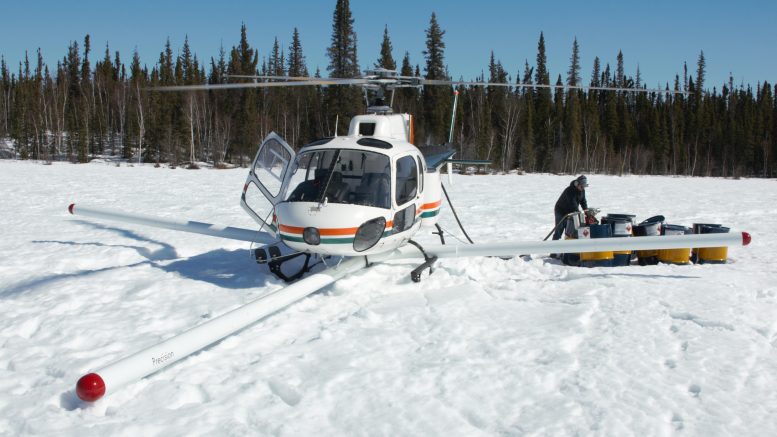Slave Lake Zinc’s (CSE: SLZ) 100%-owned O’Connor Lake project in the Northwest Territories, about 185 km southeast of Yellowknife and 150 km east of Hay River, has the potential to be a very significant base metal producer, says Ritch Wigham, the company’s CEO.
The 188-hectare property comprises zinc and lead deposits with variable gold, silver, and copper content occurring within a mineralized structural corridor. It hosts historical workings, including a headframe and underground drifting in the Shaft zone. The zone can be traced by pits and diamond drilling over 400 metres in length and is open at depth, with the deepest historic drilling intersecting mineralization down to 200 metres.
According to Wigham, supply shortages of the base metals necessary for upgrading North America’s infrastructure is leading to rising prices and the need to develop domestic sources of base metals. “Consequently, the current climate is very favourable for advancing the exploration and potential development of O’Connor Lake,” he said.
A supply gap of zinc in North America, he added, is also expected to occur over the next few years as zinc production drops, putting further upward pressure on prices and driving the need for new sources of zinc to come online as soon as possible.
Currently, the primary use of zinc is in the galvanization of steel and iron for use in the construction and automotive industries, which accounts for over 60% of global zinc consumption.
However, the global shift towards a green, sustainable economy is opening new markets for zinc, such as zinc-based hybrid flow batteries for power storage in renewable energy systems.
The raft of post-Covid-19 infrastructure stimulus packages will also lead to increased demand for “sources of high-grade base metals, especially zinc, driving prices even higher,” he said.
Osisko Metals’ (TSXV: OM; US-OTC; OMZNF) decision to re-open the past-producing Pine Point mine as a potentially viable zinc mine, he noted, reflects the favourable market conditions.
Previously one of the largest mines in Canada, Pine Point produced 58 million tonnes of mineralized material grading 7% zinc and 4% lead between 1964 and 1987.
O’Connor Lake, which lies 148 km east of Pine Point, will also benefit from Osisko’s decision to rehabilitate Pine Point, Wigham said. “That’s very important for us downstream because it creates railhead infrastructure very close to us as that we can also take advantage of in the development of O’Connor Lake.”
O’Connor Lake already benefits from existing infrastructure. The 18-megawatt Taltson hydropower plant, which supplies low-cost electricity to Fort Smith, Hay River, and Fort Resolution, is approximately 60 km to the south of the property; the site is serviced by regular charter flights from Fort Smith, Yellowknife, and Hay River; and an all-weather road links Hay River through Pine Point to Fort Resolution, where a 45-km winter road could be re-established to connect to the property, he said.
The discovery of high-grade base and precious metal showings at the property date to the late 1940s. Development of the property in the 1950s lead to significant infrastructure, including the 45-km winter access road; a three-compartment shaft sunk to a depth of 55 metres; and a drift station cut at 45 metres to access the vein system. Analysis of a 24-tonne bulk sample during this period returned grades of 55% lead, 13.5% zinc, and 84.4 grams silver per tonne.
At the time, however, low metal prices halted further development of the property.
Since acquiring the property in 2002, Slave Lake Zinc has undertaken extensive prospecting, mapping, and grid-controlled geophysical surveys. The work identified a mineralized trend exceeding 1,100 meters in length and extending 700 meters south from the historic headframe area.
Samples taken from trenches 500-600 metres along the trend from the historical Shaft zone returned assays exceeding 20% combined zinc and lead. These results, noted Wigham, were consistent with earlier results from the zone.
Slave Lake Zinc recently completed an 880-line-km airborne gradient magnetic and VLF electromagnetic survey of the property. The geophysical survey, centred over the historic exploration shaft, is the first application of modern, state-of-the-art exploration techniques on the property, said Wigham.
“While only a third of the survey results have so far been analysed, the initial results indicate the presence of multiple northwest-trending structures,” he said. “These structures intersect rocks that may host the main zone of mineralization contained in an extensive vein fault system and is probably of hydrothermal origin.”
The company is currently processing and interpreting the remaining data, the results of which will inform follow-up ground-based exploration and drilling programs, which, he said, are expected to start soon.
In addition, following an extensive consultation process, Slave Lake Zinc has signed a Collaboration Agreement with the Northwest Territory Metis Nation to facilitate exploration of O’Connor Lake. The Northwest Territory Metis Nation represents the Metis population of Hay River, Fort Smith, and Fort Resolution, and are currently negotiating a regional land settlement withdrawal agreement with the Federal Government of Canada.
The preceding Joint Venture article is PROMOTED CONTENT sponsored by Slave Lake Zinc and produced in cooperation with The Northern Miner. Visit zinccorp.ca for more information.


Be the first to comment on "JV Article: Modern exploration techniques could unlock potential of Slave Lake Zinc’s O’Connor Lake"